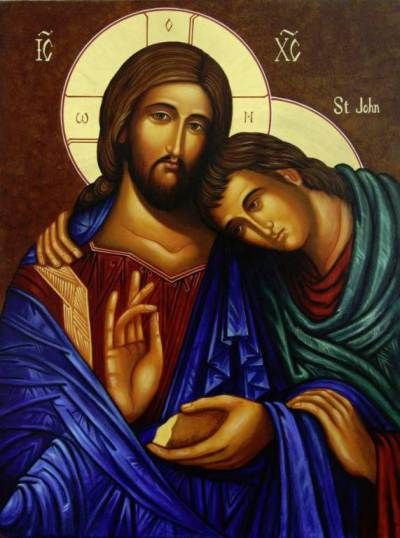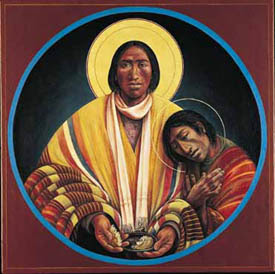A Sermon by The Rev. Barbara Mraz, October 24, 2021
In the name of Jesus,
who offers us a place to rest.
Seeing clearly is a gift and a choice.
One and a half million Americans undergo cataract surgery each year where a cloudy lens in the eye is liquified, vacuumed out and then replaced. It’s a modern miracle, yet worldwide, cataracts are still the leading cause of blindness because the surgery isn’t available in many places.
One of the most famous Impressionist painters, Claude Monet, refused this surgery in 1920 when his doctors advised it. In a poem about this, Liesl Mueller imagines him saying,
“Doctor, you say there are no haloes
around the streetlights in Paris
and what I see is an aberration
caused by old age, an affliction.
I tell you it has taken me all my life
to arrive at the vision of gas lamps as angels,
to soften and blur and finally banish
the edges you regret I don’t see,
to learn that the line I called the horizon
does not exist and sky and water,
so long apart, are the same state of being.
… I will not return to a universe
of objects that don’t know each other,
as if islands were not the lost children
of one great continent. The world
is flux, and light becomes what it touches,
becomes water, lilies on water,
above and below water,
becomes lilac and mauve and yellow
and white and blue…..
Doctor, if only you could see
how heaven pulls earth into its arms
and how infinitely the heart expands
to claim this world, blue vapor without end.”
Sight — clear 20/20 vision — changes things. It brings unspeakable beauty, but also choices and sometimes obligations. The blind don’t see race, color, gender, age, physical ability but we who have the privilege of seeing these things can become obsessed with certain elements of difference.
You can’t unsee things either: Images of suffering or brutality or moments of such neglect or privilege that we want to forget. I want to forget about the movie I saw where the truly jaded and ridiculously bored and rich are directed to a remote island where they are invited to dine on the meat of endangered species, the next exotic privilege when you are bored with everything else? Perhaps the images we can’t unsee are more personal like a person walking out the door away from us or deathly ill in a hospital bed.
Two of today’s lessons are about sight being restored, one symbolically and one physically.
Job is the go-to story for explaining suffering. All matter of pain is inflicted on Job and he calls out to God asking why? In some of the most beautiful and poetic verses in all of the Hebrew Scriptures, God responds that it’s because I’m God and you’re not, and by the way, “Where were you when I created the world? Who determined its measurements? On what were its bases sunk, or who laid its cornerstone, when the morning stars sang together?”
Job responds, “I have heard of you by the hearing of the ear, but now my eyes see you, and I repent in dust and ashes.” And Job’s fortunes are restored.
Sight is restored physically for the blind beggar Bartimaeus. He calls out to Jesus and people tell him to be quiet, so he calls out more loudly, using a different strategy, adding, “Son of David, have mercy on me!” Jesus stops, and clearly expecting something big, Bartimaeus throws off his cloak and “springs up” and goes to Jesus. Jesus asks him, “What do you want me to do for you?”
“My Teacher, let me see again.” He wants his sight restored (Was it cataracts?) Jesus heals him and he follows him to Jerusalem where, shortly, a truly terrible sight will await on a hill outside the city named Golgotha.
Our individual and collective vision has been profoundly changed since the pandemic began. Many of us see our own vulnerability in greater relief. While 911 had clear perpetrators, there are various theories about the origin of Covid, but the prevailing one is that it was started by a diseased bat in Wuhan, China. A tiny, winged creature — often part of comic Halloween scariness– changes the world.
Some of us see an ignorance that pervades our country, the disregard of science in the name of personal freedom and the cost paid in human life.
We see more violence. With the isolation due to Covid, domestic violence is up nearly 10%. Violence in general is up 30% since 2020. Tempers flare around race and who owns what lane on the freeway; guns are freely available; sources to help the mentally ill have shrunk. There is more screen time due to isolation and the accompanying desensitization that exposure to violent images can cause.
On the other hand, we are becoming kinder people. Everyone’s a preacher now and sites that sell products and services also put in good words for good deeds; one newscaster signs off by telling us to take care of ourselves and each other. At the school where I used to work, the annual celebration of alumni now focuses almost exclusively on those who have created services or businesses that help people. Public service is in. After I stumbled and almost fell at a store last week, a young black man grabbed my arm and then thanked me for the privilege of helping.
What if Jesus asked you the question he puts to Bartimaeus: What do you want me to do for you? How would you answer?
Most of us see ourselves as deficient in some way – or at the very least different in a way we don’t like. Too tall, too short, too young, too old, too fat, too unfit, too addicted; we limp or we slump, we bear scars. As I was still struggling with this sermon Saturday morning, this story arrived in my email:
A UCC clergyperson recalls that “at a retreat once, a woman in a wheelchair spoke up: ‘I’ve been using this chair for 27 years. It took 20 for me to stop believing I needed fixing. Don’t tell me I’m not whole…”
Over the years she’d stomached a lot of glib churchy talk about wholeness and healing. The message was clear: her body is substandard, but—good news—she’ll be getting a new improved version in paradise!
It pissed her off. Talk like that dishonored her body and delivered only shame. She reminded us that Jesus’ resurrected body bore the wounds of spear and nails. It still does, and forever will. “Christ’s body is a disabled body,” she said. “You’re saying he’s not whole?”
The group asked me to celebrate Communion to close the retreat. When I took bread to bless it, she cut me off before I could say the words, and said them herself: This is my body.’”
Also in the Saturday email box, from Frederick Buechner, describing Jesus as “the man of sorrows and acquainted with grief. The one with the cauliflower ear and the split lip. By whose swollen eye and ruptured spleen we are somehow healed.”
If Jesus is one of the faces of God — and I believe there are other faces — that face may not be the perfect one we hold in our minds. Jesus of the long, highlighted Hollywood wavy hair, of the flowing robes and perfectly proportioned face. It may not be like this at all. The person of Jesus was most likely dark-skinned, being from this part of the world.
Most of see God and Jesus largely in ways that we have learned in church or from the Bible. While we are given no Biblical clues about the appearance of Jesus, artists and painters have created images: the Pieta — the sculpture of Mary holding the body of Jesus; Jesus as the Good Shepherd, Jesus praying in the Garden of Gethsemane, cheesy contemporary paintings that some of us grew up with: an always-good-looking Jesus knocking at a door or holding a lantern. Some are very moving, most not. And of course, Davinci’s painting of The Last Supper.
Recently I heard a sermon online about “The Disciple Whom. Jesus Loved” — that is John. And the words and the images that I heard there changed how I saw Jesus and God. I’ll give you an imperfect summary of part of the sermon and then a link to it in a blog next week. It is a sermon at the recent installation of the rector at a large church in Atlanta. The preacher is Barbara Brown Taylor.
Speaking of the beloved Disciple, the mysterious one whom Jesus loved and who is mentioned five times in John’s gospel but never named, Taylor recalls the Last Supper, in John’s Gospel. Jesus was giving directions for when he would no longer be with the disciples and trying to console them. The unnamed “Disciple Whom Jesus Loved” is in some translations “sitting next to Jesus,” or “reclining near Jesus,” or “seated at the right of Jesus,” and, she says, “according to the chicken translators of the NSR, this disciple was “lying close to the breast of Jesus.”
But in the original Greek, she says, he was “laying on the Bosom of Jesus! His head is on the chest of the Jesus, so close he could hear the beating of Jesus’ heart. As Jesus taught the disciples, he heard the teaching with one ear, and the heartbeat with the other.
How we see this makes a difference in countless ways: Was there a romantic relationship here? Did Jesus love this disciple and only “like” the rest ? Most importantly, where are we in the picture?
This is Jesus as a resting place for us all, beyond time, “where his friends can rest between shifts of doing his work in the world,” at a meal they could return to “where you could have said anything and still get your feet washed, a meal that is always there.’
This is a new way to see Jesus, to comprehend God, as one who not only heals, restores, or is a kind of cosmic vending machine where you insert prayers and answers spill out, but as a presence that welcomes, loves us beyond understanding, and whose heartbeat we can hear and see in the universe, in the cadence of the changing seasons, in the sustained note connecting earth and sky that Money perceived, in the rhythms of violence and kindness that pervade America today. This is God as comfort, God as resting place, God as warmth, God at God’s most tender.
When I searched for artwork portraying John on the breast of Jesus, I found it was everywhere. I’ve brought some examples that will be by the door in the back when you leave and when this sermon is posted online I’ll add some of them. They are inexpressibly tender and loving. See them and think about how this affects how you understand Jesus, that face of God, turned in our direction.
But wait — right over the altar by the wall is a wood cutting of the Last Supper. Who is sitting on the right of Jesus? That really looks like a woman…. at the Last Supper? What’s THAT about?
Take a look. See— for yourself. They say seeing is believing.
Amen.
Sources:
Frederick Buechner, Telling the Truth, 1977.
Mary Luti, “This Is My Body,” in Daily Devotional, October 23, 2021.
Liesel Mueller, “Monet Refuses the Operation,” in Second Language, 1996.
Working Preacher, online. Commentaries on Mark.
The Rev. Barbara Brown Taylor, Institution of the 23rd Rector of St. Luke’s in Atlanta, Oct. 17, 2021. Available online.
Statistics on violence from U S News and World Reports, Feb. 25,



